You can store various foods in earth pits for several months when you maintain proper conditions. Root vegetables like carrots and parsnips will last 4-6 months at 32-40°F with 90-95% humidity. Potatoes stay fresh for up to 120 days when kept at 38-45°F, while tubers remain viable for 10-14 weeks at 40-45°F. Your success depends on creating a well-drained pit below the frost line, using proper insulation layers, and installing ventilation to prevent mold growth. Mastering these storage techniques can transform your pit into a natural refrigerator that preserves your harvest through winter.
Earth Pit Storage Basics
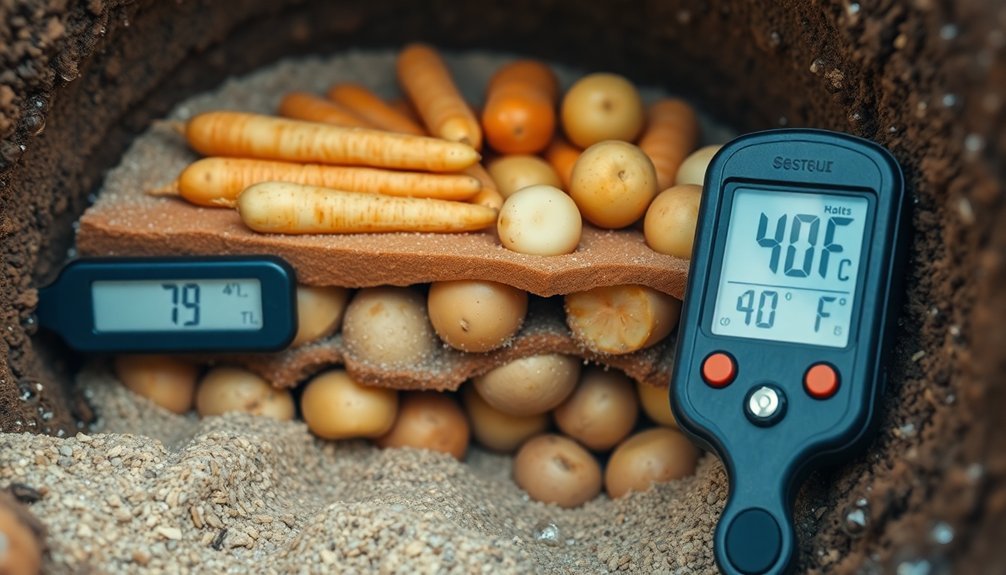
In the world of traditional food storage, earth pits serve as natural refrigerators that maintain surprisingly stable temperatures year-round.
You'll need to start by selecting a well-drained, shady location away from water sources to prevent moisture problems that can spoil your stored food.
To create an effective earth pit, you'll want to dig below the frost line and incorporate proper insulation layers.
Start with sand or sawdust at the base, then add materials like leaves, bark, or grasses along the sides. You can strengthen the insulation by lining the walls with rocks or logs if you have them available.
For protection from the elements, you'll need to cover your pit with a weighted-down waterproof tarp and add layers of leaves and straw on top. The ideal temperature range for storage is between 32° and 40° F.
Don't forget to create a drainage trench around the perimeter to direct water away from your storage area.
Your pit should include a ventilation system, often achieved through a vertical wooden duct, to regulate temperature and humidity.
Consider installing an access hatch or well box – you'll appreciate the convenience when it's time to retrieve your stored items.
Root Vegetables Storage Duration
Most root vegetables can survive remarkably well in earth pit storage, with proper storage times ranging from 2-6 months depending on the specific vegetable. You'll find that carrots and parsnips last the longest, staying fresh for up to 6 months when stored properly at 32-40°F with 90-95% humidity.
To maximize storage duration, you'll need to prepare your vegetables correctly. Don't wash them – just brush off excess soil. Cut the tops back to 1-2 inches and layer them carefully with insulating materials like sand or sawdust in your earth pit. Regular ventilation is crucial to prevent moisture buildup and mold growth in your storage area.
| Vegetable | Storage Duration | Ideal Temperature |
|---|---|---|
| Carrots | 4-6 months | 32-40°F (0-4°C) |
| Parsnips | 4-6 months | 32-40°F (0-4°C) |
| Beets | 3-4 months | 32-40°F (0-4°C) |
| Rutabagas | 3-4 months | 32-40°F (0-4°C) |
| Turnips | 2-4 months | 32-40°F (0-4°C) |
Remember to monitor your storage conditions regularly. If you notice any signs of rot or decay, remove affected vegetables immediately to prevent spread to others. You can extend storage life by maintaining proper ventilation and protecting your pit from rodents using wire mesh barriers.
Potato Preservation Time Frames
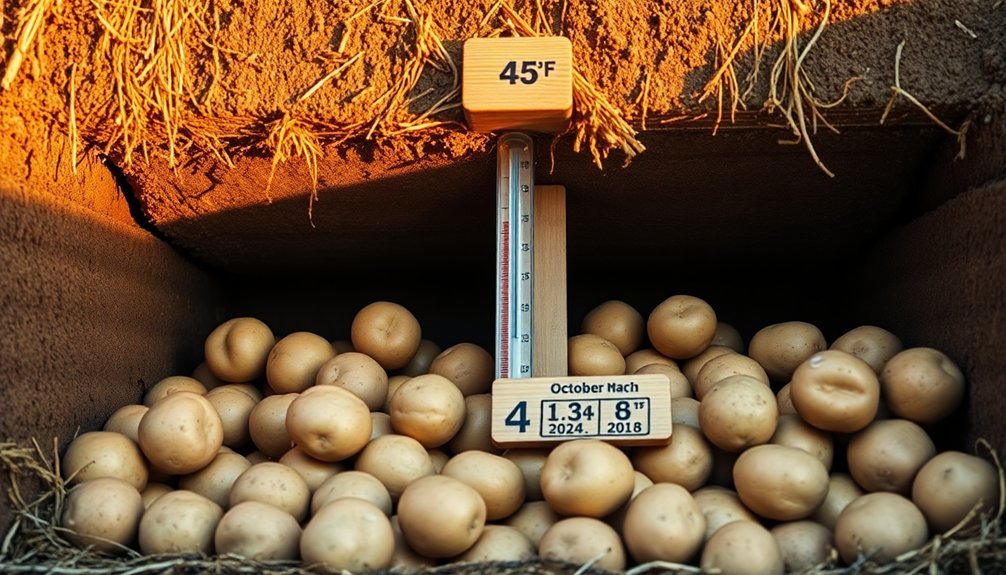
Potato storage success depends heavily on maintaining precise environmental conditions in your earth pit. You'll need to maintain temperatures between 38° to 45°F and 95% relative humidity while ensuring proper air movement throughout your storage space.
When you store potatoes correctly in ground pits, they'll last up to 120 days or through the winter months. Store in dry areas away from spots where water pools to prevent rot. You can maximize your storage success by using an improved pit design with a clean plastic barrel positioned at a 45-degree angle. Layer your potatoes between clean, dry straw and cover them with at least 3 inches of soil to protect them from the elements.
Before long-term storage, you'll want to heal any wounds on your potatoes. Keep them at 60° to 65°F with high humidity for 3 to 5 days to start the healing process, which can take up to 20 days to complete.
Don't rush the cooling process, as this can lead to rot. If you're storing for market value, you'll be pleased to know that properly stored potatoes can double in value after 6 months, making the extra effort worthwhile.
Storage Life Of Tubers
Beyond potato storage, other tubers require specific conditions to maintain their quality during earth pit storage. When you're storing tubers in an earth pit, you'll need to maintain temperatures between 40-45°F and relative humidity of 74-85% to prevent moisture loss and decay.
You'll also want to guarantee proper air circulation to minimize storage losses and maintain tuber quality. To maximize storage life, you'll need to cure your tubers first. Place them in a dark, dry location at 17-20°C for 6-8 days to harden their skin and prevent bruising.
In your earth pit, layer the tubers with materials like vermiculite, peat moss, or wood shavings to prevent direct contact and maintain humidity. You can also wrap them in newspaper for additional protection.
With proper storage conditions, you can expect your tubers to maintain their quality for 10-14 weeks. However, you'll notice some natural changes over time, including fresh mass loss and decreased firmness.
The soluble sugar content will increase as water loss concentrates the solutes. To extend shelf life further, you might consider using sprouting inhibitors, though this isn't necessary for typical earth pit storage.
Optimal Pit Conditions
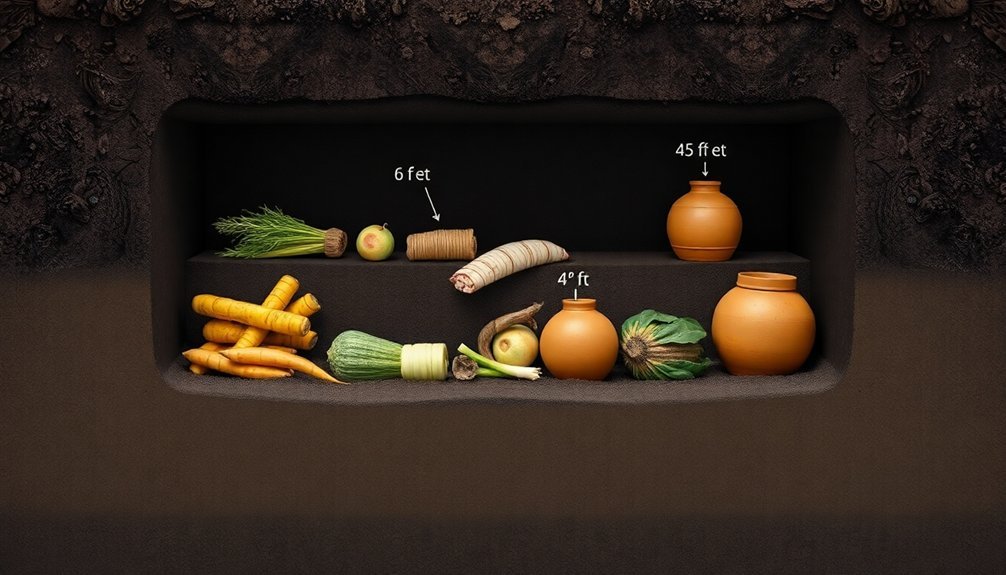
With careful attention to detail, maintaining ideal conditions in your earth pit storage requires precise control of temperature, humidity, and drainage.
You'll need to keep temperatures between 32-40°F for optimal storage, though most pits naturally average 50-55°F in northern regions. You can adjust temperatures by introducing cold or hot objects through the central duct, and you should take advantage of cold nights to lower temperatures before storing produce.
Your pit's humidity needs will vary by crop type. Root crops thrive at 90-95% relative humidity, while squash and pumpkins prefer 60-75%. You can increase moisture by adding water through the shaft with an aluminum foil evaporator, or reduce it using desiccants.
Proper drainage is essential for success. Install a gravel-filled trench around your pit and use plastic sheet lining to control ground moisture.
You'll want to bank the pit with earth and clean insulating materials to maintain stable conditions. Position your access hatch above ground level and arrange produce in sacks on ropes for easy inspection.
Check your stored items every couple weeks and adjust conditions based on weather changes.
Signs of Food Spoilage
Monitoring food for signs of spoilage in your earth pit requires attention to four key indicators: visual changes, odors, texture alterations, and taste differences.
When you inspect your stored food, watch for visual warning signs like darkening or browning of meats, discoloration in dairy products, or fuzzy patches of mold.
You'll want to check if vegetables have developed a slimy film or if eggs show grayish-black spots on their shells.
Your nose can detect significant spoilage indicators. If you notice unpleasant, rancid, or ammonia-like smells when opening your pit, your food may be compromised.
Sour or musty odors in carbohydrate-rich foods are particularly concerning.
Pay attention to texture changes. If meat becomes unusually sticky or dry, or if vegetables turn soggy, they're likely spoiled.
You'll also want to notice if tofu loses its elasticity or if foods develop a gritty or slimy consistency.
Finally, check for packaging issues. If you spot swollen or bulging containers, that's a clear sign of microbial activity.
Remember that gas production and pH changes can occur even when food is stored underground, so regular monitoring is essential.
Extending Storage Life
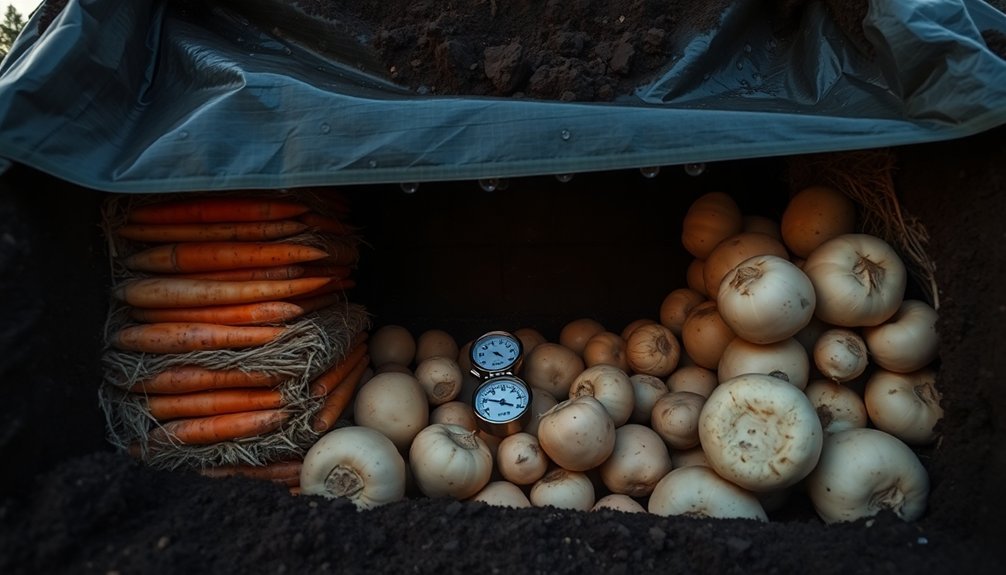
In earth pit storage, maximizing your food's shelf life depends on creating ideal environmental conditions. You'll need to dig your pit below the frostline and guarantee proper drainage to maintain consistent temperatures while keeping moisture at bay.
Line your pit with rust-resistant metal mesh or a perforated washing machine drum to protect against pests while allowing essential airflow.
To extend storage duration, you'll want to layer your food carefully. Start by placing straw or dry leaves at the bottom for insulation, then arrange root vegetables like potatoes, carrots, and beets strategically.
If you're storing cabbages, place them upside down with roots intact. Create barriers between different food types using additional straw layers to prevent cross-contamination and moisture transfer.
Don't forget to install a ventilation shaft using bundled twigs or metal mesh to prevent mold growth. In areas with heavy snowfall, you'll need extra protection against moisture seepage.
Mark your pit's location clearly so you can access it throughout the winter months. With these measures in place, your root vegetables can last several months, though you should check them regularly for any signs of deterioration.
Seasonal Storage Guidelines
Successful earth pit storage depends heavily on the shifting seasons and local climate patterns. You'll need to adjust your storage methods throughout the year to maintain ideal conditions for your vegetables.
During dry seasons, you'll want to monitor moisture levels carefully. Pour a little water over the storage pit when conditions become too dry, but avoid excess moisture that can lead to rot. In hot weather, the earth pit helps keep your vegetables cool, while the 25-50cm layer of soil or sand provides consistent temperature control.
For winter storage, mark your pits with stakes so you can locate them easily in snowy conditions. You'll find that root vegetables, winter squash, and tubers like cassava and potatoes store particularly well during cold months.
Create horizontal straw tunnels to help excess moisture and gases escape, which becomes especially important during wet periods. You can maximize storage duration by separating different vegetable types into their own pits.
While storage times vary, most vegetables last a few months in dry conditions. Winter squash typically keeps for 1-2 months, and you'll get the best results by regularly checking for and removing any spoiled produce.
Climate Impact on Preservation
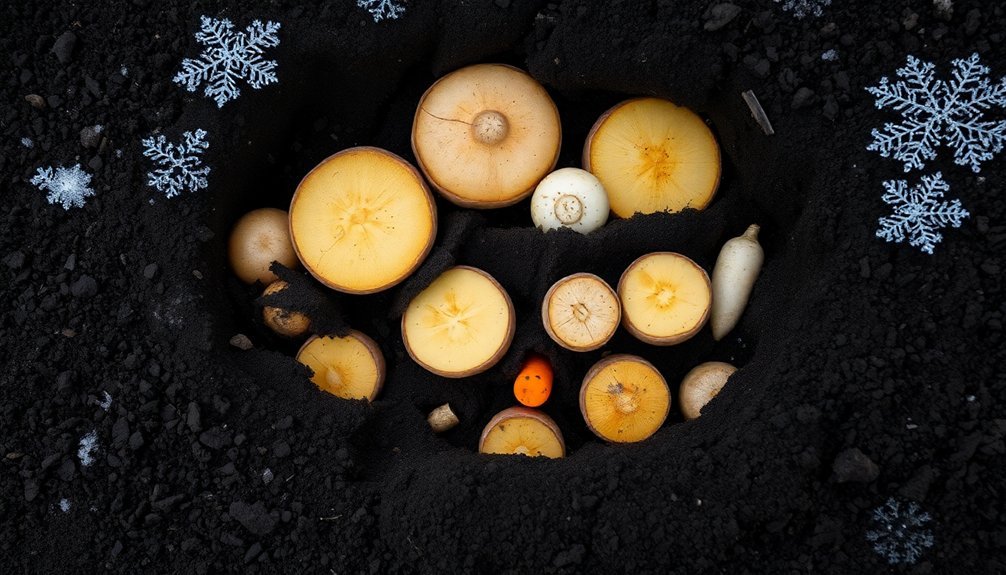
You'll find that your local temperature zone heavily influences how long foods can stay preserved in earth pits, with colder climates generally offering better storage conditions.
Your pit's effectiveness directly depends on maintaining consistent temperatures, which means seasonal shifts and extreme weather events can dramatically impact food preservation times.
If you're in an area with high rainfall, you'll need to account for increased moisture levels that can reduce storage life and require additional waterproofing measures to prevent spoilage.
Temperature Zones Matter Most
Understanding temperature zones becomes critical when storing food in earth pits, as climate directly impacts preservation success. You'll need to monitor temperatures carefully, as food becomes vulnerable to bacterial growth between 41°F and 135°F (5°C to 57°C). This danger zone is particularly concerning when using traditional storage methods like earth pits.
| Temperature Range | Safety Status | Required Action |
|---|---|---|
| Below 40°F (4°C) | Safe Zone | Monitor regularly |
| 41-135°F (5-57°C) | Danger Zone | Remove food immediately |
| Above 135°F (57°C) | Safe Zone | Not suitable for earth pits |
You'll want to position your earth pit where it can maintain temperatures below 40°F (4°C). If you're in an area with permafrost, you'll need to take into account recent climate changes that might affect storage stability. When temperatures rise above the safe zone, you must follow the 2-hour/4-hour rule: if food has been in the danger zone for less than 2 hours, it's safe to continue storing; between 2-4 hours, use immediately; beyond 4 hours, you must discard it. Regular temperature checks become your best defense against spoilage, especially as warming trends continue to impact traditional storage methods.
Rainfall Affects Storage Life
Beyond temperature concerns, rainfall patterns can dramatically alter how long your food stays preserved in earth pits. When you're dealing with increased precipitation, the soil moisture levels rise, which can compromise your storage structure's integrity and create prime conditions for harmful pathogens.
You'll notice that excessive moisture prevents proper air drying of traditional foods like fish, caribou, and seal, leading to faster spoilage rates. Flooding poses an even greater threat to your underground storage. Water infiltration can disrupt the natural temperature regulation and bring contaminants into your storage area.
During drought periods, you'll face different challenges as dry soil loses its insulating properties and becomes more susceptible to erosion.
Here's what you need to watch for in your earth pit storage:
- High soil moisture can cause structural instability and reduce thermal insulation
- Water infiltration from floods can contaminate food and compromise preservation
- Dry conditions may increase temperature fluctuations and attract pests
- Extreme weather events can suddenly disrupt storage conditions and speed up spoilage
To maintain ideal storage conditions, you'll need to adapt your pit design based on local rainfall patterns and include proper drainage systems.
Moisture Control Methods
Throughout the storage process, controlling moisture levels remains critical for preserving food in earth pits. You'll need to implement multiple moisture control methods to protect your stored foods from spoilage and degradation.
You can start by ensuring proper air circulation within your pit. Install ventilation systems that allow dry air to flow while pushing out moisture-laden air. You'll want to seal any unnecessary openings to prevent moist air infiltration, and consider using dehumidifiers to maintain ideal moisture levels.
For the food items themselves, you've got several preservation options. Air drying works well for herbs, vegetables, and some meats, using natural circulation to remove moisture slowly. If you're storing items that need more protection, consider freeze-dried foods, which maintain their nutritional value and can be easily rehydrated when needed.
Surface treatment of your pit's walls is equally important. You should insulate surfaces to prevent condensation and keep them warm above the dew point. Consider applying condensation-resistant coatings and using heat tape or lamps in particularly problematic areas.
Don't forget to cover any moist products to prevent water vapor from affecting other stored items.
Temperature Monitoring Requirements

Temperature monitoring systems play an essential role in maintaining food safety within earth pits. You'll need to implement regular temperature checks to guarantee your stored food remains within safe ranges, typically aiming for 41°F (5°C) or below for cold storage.
While earth pits naturally maintain cooler temperatures than above-ground storage, you must still verify these conditions using calibrated thermometers and maintain detailed documentation of your readings.
Your monitoring protocol should include:
- Daily temperature checks at multiple pit depths
- Documentation of readings in a temperature log
- Regular calibration of monitoring devices
- Immediate corrective actions if temperatures exceed safe ranges
You'll need to establish monitoring points throughout your earth pit system, particularly at the entrance and at varying depths.
It's important to track temperature fluctuations during different seasons and weather conditions, as these can greatly impact pit temperatures. Keep detailed records of all readings, calibration checks, and any corrective actions taken.
If you're using electronic monitoring systems, make sure they're properly protected from moisture and dirt while maintaining accurate data storage capabilities.
Remember that proper temperature control directly affects how long your food will remain safe and edible in the earth pit.
Common Storage Problems
Storage challenges in earth pits can seriously compromise your food preservation efforts if not properly managed. The most essential issue you'll face is water infiltration, which can occur through surface runoff, wall cracks, or subsoil seepage.
During heavy rainfall or flash floods, your pit may completely fill with water, resulting in total food loss.
You'll also need to contend with various biological threats. Insects like the maize weevil can greatly damage your stored grain, while rodents frequently find their way into pits.
Mold growth, particularly Aspergillus and Penicillium, poses serious health risks through mycotoxin production, and you might experience breathing difficulties when opening affected pits.
The physical environment presents additional challenges. You'll inevitably deal with soil contamination in unlined pits, requiring extra cleaning effort.
Your pit's location is essential – you'll need to place it on high ground in suitable soil to prevent collapse.
The storage conditions will affect your food's viability, particularly for seeds, which can lose their germination capacity.
These problems often lead to market rejection of your grain, impacting your household income and food security.
Harvesting and Storage Timing
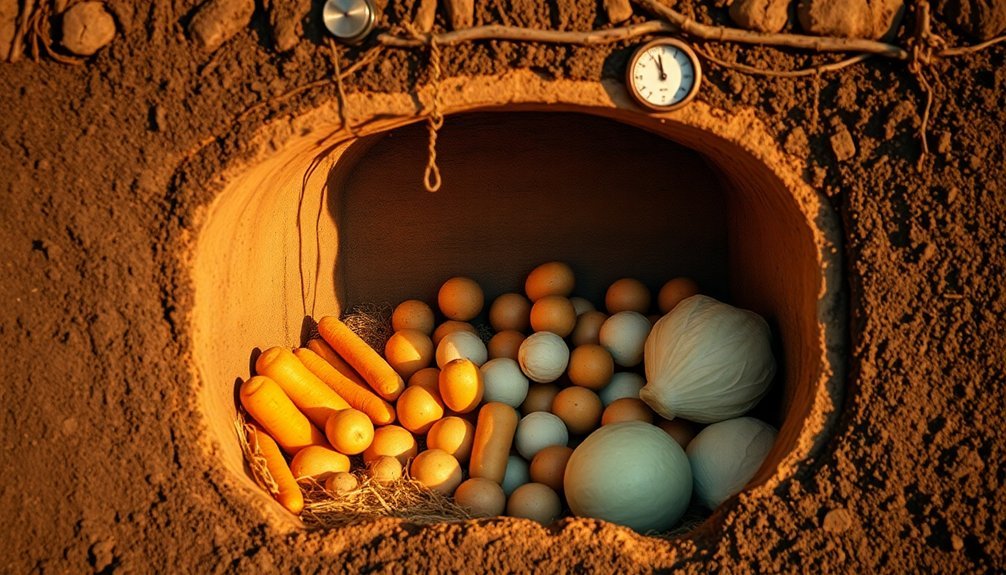
You'll want to harvest your crops during dry weather when they've reached full maturity but aren't overripe, as moisture-laden produce won't store well in earth pits.
Before moving your harvest into storage, make certain the moisture content is appropriate – particularly for grains, which should be thoroughly dried to prevent spoilage.
Handle your freshly harvested foods with care to prevent bruising or damage, and clean off excess soil before placing them in your storage pit.
Ideal Harvest Weather Conditions
The success of your earth pit storage begins with proper harvest timing and weather conditions. You'll want to harvest your vegetables during cool, dry weather to prevent rot and guarantee ideal storage life.
Avoid collecting produce when it's wet outside, as moisture can lead to premature spoilage and fungal growth in your earth pit.
For root vegetables and tubers that you'll store in earth pits, timing is particularly important. Watch the weather forecast and plan to harvest before any hard freezes, especially for sensitive crops like sweet potatoes.
However, some crops like rutabagas actually benefit from exposure to a couple of light frosts before harvesting.
Key weather considerations for harvesting:
- Choose a dry day with low humidity to prevent moisture-related issues
- Harvest during cool morning hours when vegetables are crisp and well-hydrated
- Wait for several days after heavy rain to allow soil to dry sufficiently
- Monitor frost forecasts to protect sensitive crops while taking advantage of cold-hardy varieties
Handle all produce gently during harvest, regardless of weather conditions.
Even minor damage from rough handling can lead to rapid deterioration once vegetables are placed in your earth pit.
Moisture Content Before Storage
Maintaining proper moisture levels stands as a critical factor for successful earth pit storage. You'll need to verify your grains reach appropriate moisture content before placing them in your earth pit to prevent spoilage and extend storage life.
| Grain Type | Safe Storage Moisture |
|---|---|
| Soybeans | Up to 11% |
| Corn | Up to 13% |
| Wheat | Up to 13.5% |
| Rice | Up to 13.5% |
For long-term pit storage extending beyond 5 years, you'll want to reduce these moisture levels by an additional 2%. High moisture content creates an ideal environment for mold growth and bacterial reproduction, particularly when moisture exceeds 13.5%. You're risking significant spoilage if you store grains with moisture levels above 15%, as this promotes fungal growth and mycotoxin production.
Before measuring moisture content, let your grain samples warm to room temperature in a sealed plastic bag for accurate readings. Remember that proper moisture control can dramatically extend storage life – for instance, reducing corn's moisture content by just 1% (from 15% to 14%) can increase its storage life by approximately 75 days at 70°F.
Post-Harvest Handling Practices
Successful earth pit storage begins with proper post-harvest handling practices.
You'll need to harvest your crops at peak maturity, ideally early in the morning when moisture and flavor content are highest. Once you've harvested your produce, immediately sort through it to remove any damaged or decaying items that could spread pathogens to healthy crops.
Clean and sanitize all your harvesting equipment and containers to prevent contamination.
Before placing your produce in earth pits, you'll want to implement proper cooling procedures to extend storage life and reduce food safety risks.
Don't over-pack your harvest, as this can lead to bruising and excessive moisture loss that'll affect storage duration.
- Look for specific maturity signs in different crops (like sweetness in cantaloupes) to determine ideal harvest timing
- Sort produce based on size, quality, and condition to guarantee uniform storage conditions
- Remove any items showing signs of disease, injury, or decay immediately
- Cool your produce to the appropriate temperature before pit storage to enhance shelf life
Following these post-harvest practices carefully will greatly impact how long your food lasts in earth pits and maintain its nutritional value throughout storage.
Frequently Asked Questions
Can Different Types of Vegetables Be Stored Together in the Same Pit?
You can store compatible root vegetables together, but you'll need to separate ethylene-sensitive crops. Keep potatoes, carrots, and beets together, while storing cabbage and broccoli elsewhere to prevent spoilage.
How Do You Safely Retrieve Vegetables Without Disturbing Others in Storage?
You'll want to dig carefully at the pit's side, creating a small access point. Remove only what you need, then reseal with straw and soil to protect remaining vegetables from exposure.
What Alternative Materials Can Replace Straw or Leaves for Insulation?
You can replace straw with rigid foam insulation like polyiso or XPS, spray foam insulation, or insulated metal panels. They'll provide better moisture resistance and thermal performance than traditional organic materials.
Should Earth Pits Be Covered During Heavy Rainfall or Storms?
Yes, you should always cover your earth pits during heavy rainfall and storms. It's crucial to prevent water damage, flooding, and spoilage. Don't wait until it starts raining – secure your pit's covering beforehand.
Can Earth Pits Be Reused for Multiple Storage Seasons?
Yes, you can reuse earth pits for multiple seasons if you keep them dry, clean, and free from contamination. You'll need to inspect for damage, make repairs, and properly seal them between uses.
In Summary
You'll get great results storing root vegetables and tubers in your earth pit when you maintain proper moisture and temperature control. Remember to check regularly for signs of spoilage and guarantee adequate drainage. Most root vegetables will last 3-6 months, while potatoes can survive up to 8 months if conditions are ideal. Don't forget to harvest at peak maturity and store only undamaged produce.

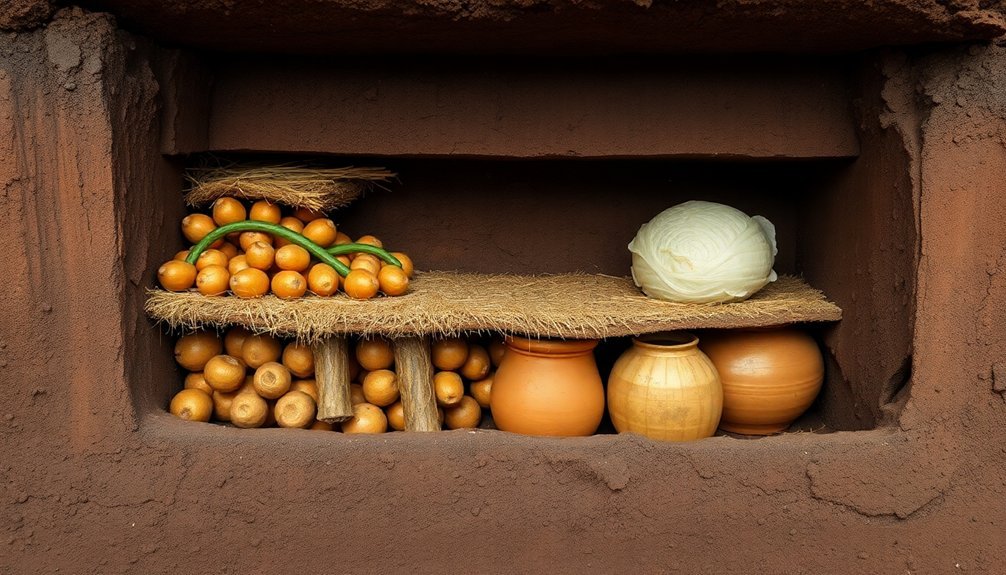



Leave a Reply